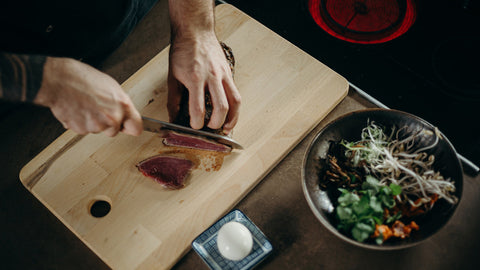While you might not be cooking five-star meals or food styling all the time, it's still important to have basic knife skills for cutting bread or butternut squash. You may also chop parsley and many other things.
It's unnecessary to attend cooking school to become a better cook. These articles and tutorials can help you learn the difference between a long knife and a shorter one and practice your skills. That way, you can save time in the kitchen and know how to handle a knife correctly!
Tips for Improving Basic Kitchen Knife Skills
1. Always Start with a Sharp Knife
Sharp knives can be scary, but they actually reduce the risk of injury when compared to dull knives. That's because a dull knife makes it harder to cut through the ingredients. There's a good chance that the blade could slip off the food and into your finger. Ouch!
A sharpened knife, however, cuts swiftly through the ingredients without a lot of pressure or strain from you. This reduces the risk of injuries, and it cuts down on the chopping time!
It's easy to keep your knives sharp by using a professional sharpener. However, you can use a honing steel between normal uses and store the knives on a magnetic strip to protect them.
Therefore, it's important to learn how to use the sharpening steel correctly so that you can practice your other knife skills!
2. Create a Flat and Stable Surface with the Cutting Board
Many cutting boards don't grip the countertop efficiently. To make the cutting board have a better grip, fold over a damp kitchen towel and place it under the board. Now, it's a stable cutting surface.
In a perfect world, the vegetables have flat edges, but that doesn't really happen. Most of them are round or have contours. Chopping circular items isn't safe and can be quite challenging. Therefore, you should always create a flat base during your first cut. That way, you chop the right size dice each time.
3. Protect Your Fingers While Using the Knife Blade
You might be scared of cutting yourself with the knife, but you can prevent that from happening. Use a knuckle guard to keep your fingers safe. While you can buy one, you may also put the fingertips on the ingredient and curl them up slightly to protect your fingers!
4. Get a Grip on the Knife (Properly)
It's important to control the knife when chopping, so you should learn how to hold the knife correctly.
Don't hold it at the back of its handle because you have no leverage over the blade. You also get less stability when chopping if the index finger points out.
The best way to get the right grip is to wrap the fingers around the knife where the handle and blade meet. Hold it like you're shaking someone's hand. Overall, this is the most stable option for basic cuts and beyond and ensures that the knife goes into the food you're cutting and not your fingers.
5. Learn the Basic Cutting Techniques
It's important to understand the different knife cuts available. When cutting ingredients, you want to be safe. The most efficient way to prepare food is based on what you're cutting. Before you start chopping, learn the different knife cuts you can make and practice them to add them to your knife skills!
The Slice
You use this technique to slice large meats and vegetables and can rough-slice herbs with a sharp chef's knife. First, find the flat side of the food, hold it steady with the non-knife hand, and hold the tip against the cutting board to make thin slices.
The Chop
You use this method to make half-moons in vegetables with a chef's knife. Consider slicing a thin section from the face of the food to get the flat surface. Hold the root end of your onion or garlic, and decide if you want a small dice, medium dice, or large dice.
Press downward with an even stroke and shift the knife a bit forward. Then, lift the blade up and repeat with your onion or any other vegetable.
The Back-Slice
This technique is great for fine-slicing delicate items with a chef's knife. When slicing herbs, make sure to stack the leaves, rolling them tightly. Hold the food steadily with the non-knife hand, put the tip of the blade against the board, and slice through without a downward motion.
The Rock Chop
You can use this technique for mincing. Roughly chop the ingredients with the slice or chop method, gathering them into a small pile. Put the tip of the knife on one side, using the other hand to hold it steady. Now, use a rocking motion with the blade and cut through all of the ingredients. It's best not to use a paring knife or serrated knife here!
Conclusion
It's crucial to have great knife skills like professional chefs. Home cooks know that they must slice large foods to cook them efficiently.
Whether you're using a utility knife or something else, you can't create serious eats without the right methods. Those in the culinary arts know what they're doing, and cooking can be an art form.
Just start slow when you're cooking initially, practice, and be safe!
